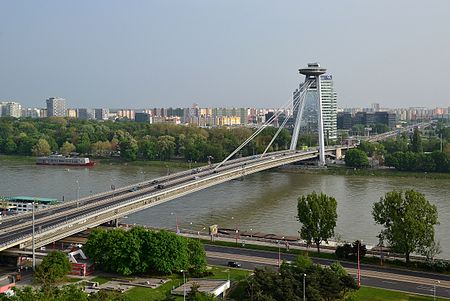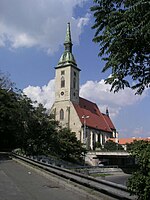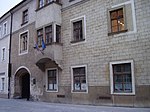Most SNP

Most SNP ("Bridge of the Slovak National Uprising"), commonly referred to as Most Slovenského národného povstania or the UFO Bridge, and named Nový most ("New Bridge") from 1993 to 2012, is a road bridge over the Danube in Bratislava, the capital of Slovakia. It is the world's longest bridge to have one pylon and one cable-stayed plane. Most SNP is an asymmetrical cable-stayed bridge with a main span length of 303 m (994 ft), a total length of 430.8 m (1,413 ft), a width of 21 m (69 ft), and a weight of 537 t (592 short tons). Its steel construction is suspended from steel cables, connected on the Petržalka side to two pillars. There are four lanes for motor traffic on the upper level and lanes for bicycles and pedestrians on the lower level. It is a member of The World Federation of Great Towers.
Excerpt from the Wikipedia article Most SNP (License: CC BY-SA 3.0, Authors, Images).Most SNP
Bridge of the Slovak National Uprising, Bratislava Dvory (District of Bratislava V)
Geographical coordinates (GPS) Address External links Nearby Places Show on map
Geographical coordinates (GPS)
| Latitude | Longitude |
|---|---|
| N 48.1384 ° | E 17.104581 ° |
Address
Most SNP (Most cestný;Most Slovenského národného povstania;UFO Bridge;Nový most)
Bridge of the Slovak National Uprising
851 01 Bratislava, Dvory (District of Bratislava V)
Region of Bratislava, Slovakia
Open on Google Maps









